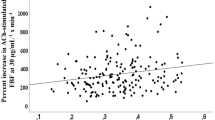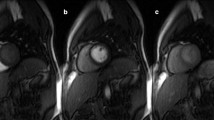Abstract
Purpose
Response of myocardial blood flow (MBF) to sympathetic stimulation with cold is modulated by endothelium-related factors and is typically altered in the presence of coronary risk factors. Determinants of flow response to cold pressor testing (CPT) in normal volunteers at low risk for CAD remain less well defined, especially relative to baseline conditions such as hemodynamics and MBF, plasma substrate and lipid levels, and total pharmacologically stimulated vasodilator capacity.
Methods
In 50 normal volunteers (42±13 years; 31 women) without coronary risk factors, insulin resistance, or family history of diabetes/premature CAD, MBF was measured with 13N-ammonia and PET at baseline, during CPT, and during pharmacologic hyperemia.
Results
Sympathetic stimulation with CPT raised heart rate and blood pressure and thus MBF (ΔMBF=0.23±0.09 ml/min/g). MBF response, defined in absolute flow units as the difference between CPT and baseline, was independent of age, gender, heart rate, and blood pressure and rate–pressure product (RPP) at baseline as well as plasma substrate and lipid levels with the exception of an association with HDL cholesterol (ρ=0.40, p=0.005) but depended on the change in RPP from rest (ρ=0.33, p=0.019). Finally, changes in coronary vascular resistance in response to CPT were associated with changes in pharmacologic vasodilation (ρ=0.56, p<0.0001).
Conclusion
MBF response to sympathetic stimulation with cold (NO-mediated endothelium-dependent vasomotion), reflecting the functional state of the coronary endothelium, was independent of gender, age, and resting heart conditions. It was modulated by HDL cholesterol levels, even in healthy volunteers, and also related to pharmacologically stimulated vasodilator capacity at the coronary vascular resistance level.



Similar content being viewed by others
References
Zeiher AM, Drexler H, Wollschlager H, Just H. Endothelial dysfunction of the coronary microvasculature is associated with coronary blood flow regulation in patients with early atherosclerosis. Circulation 1991;84:1984–92.
Zeiher AM, Drexler H, Wollschlager H, Just H. Modulation of coronary vasomotor tone in humans. Progressive endothelial dysfunction with different early stages of coronary atherosclerosis. Circulation 1991;83:391–401.
Campisi R, Czernin J, Schoder H, Sayre JW, Marengo FD, Phelps ME, et al. Effects of long-term smoking on myocardial blood flow, coronary vasomotion, and vasodilator capacity. Circulation 1998;98:119–25.
Campisi R, Czernin J, Schoder H, Sayre JW, Schelbert HR. L-Arginine normalizes coronary vasomotion in long-term smokers. Circulation 1999;99:491–7.
Di Carli MF, Bianco-Batlles D, Landa ME, Kazmers A, Groehn H, Muzik O, et al. Effects of autonomic neuropathy on coronary blood flow in patients with diabetes mellitus. Circulation 1999;100:813–9.
Di Carli MF, Janisse J, Grunberger G, Ager J. Role of chronic hyperglycemia in the pathogenesis of coronary microvascular dysfunction in diabetes. J Am Coll Cardiol 2003;41:1387–93.
Prior JO, Quinones MJ, Hernandez-Pampaloni M, Facta AD, Schindler TH, Sayre JW, et al. Coronary circulatory dysfunction in insulin resistance, impaired glucose tolerance, and type 2 diabetes mellitus. Circulation 2005;111:2291–8.
Quinones MJ, Hernandez-Pampaloni M, Schelbert H, Bulnes-Enriquez I, Jimenez X, Hernandez G, et al. Coronary vasomotor abnormalities in insulin-resistant individuals. Ann Intern Med 2004;140:700–8.
Pop-Busui R, Kirkwood I, Schmid H, Marinescu V, Schroeder J, Larkin D, et al. Sympathetic dysfunction in type 1 diabetes: association with impaired myocardial blood flow reserve and diastolic dysfunction. J Am Coll Cardiol 2004;44:2368–74.
Schindler TH, Nitzsche EU, Olschewski M, Brink I, Mix M, Prior J, et al. PET-measured responses of MBF to cold pressor testing correlate with indices of coronary vasomotion on quantitative coronary angiography. J Nucl Med 2004;45:419–28.
Schindler TH, Nitzsche EU, Munzel T, Olschewski M, Brink I, Jeserich M, et al. Coronary vasoregulation in patients with various risk factors in response to cold pressor testing: contrasting myocardial blood flow responses to short- and long-term vitamin C administration. J Am Coll Cardiol 2003;42:814–22.
Hattori N, Schnell O, Bengel FM, Rihl J, Nekolla SG, Drzezga AE, et al. Deferoxamine improves coronary vascular responses to sympathetic stimulation in patients with type 1 diabetes mellitus. Eur J Nucl Med Mol Imaging 2002;29:891–8.
Schindler TH, Nitzsche EU, Schelbert HR, Olschewski M, Sayre J, Mix M, et al. Positron emission tomography-measured abnormal responses of myocardial blood flow to sympathetic stimulation are associated with the risk of developing cardiovascular events. J Am Coll Cardiol 2005;45:1505–12.
Campisi R, Nathan L, Pampaloni MH, Schoder H, Sayre JW, Chaudhuri G, et al. Noninvasive assessment of coronary microcirculatory function in postmenopausal women and effects of short-term and long-term estrogen administration. Circulation 2002;105:425–30.
Facta A, Prior J, Schindler TH, Cadenas J, Quinones MJ, Hsueh WA, et al. Effect of glucose lowering on coronary circulatory dysfunction in type 2 diabetes mellitus [abstract]. J Am Coll Cardiol. 2004;43:339A–340A.
Matthews DR, Hosker JP, Rudenski AS, Naylor BA, Treacher DF, Turner RC. Homeostasis model assessment: insulin resistance and beta-cell function from fasting plasma glucose and insulin concentrations in man. Diabetologia 1985;28:412–9.
Porenta G, Kuhle W, Czernin J, Ratib O, Brunken RC, Phelps ME, et al. Semiquantitative assessment of myocardial blood flow and viability using polar map displays of cardiac PET images. J Nucl Med 1992;33:1628–36.
Kuhle WG, Porenta G, Huang SC, Buxton D, Gambhir SS, Hansen H, et al. Quantification of regional myocardial blood flow using 13N-ammonia and reoriented dynamic positron emission tomographic imaging. Circulation 1992;86:1004–17.
Chan SY, Brunken RC, Czernin J, Porenta G, Kuhle W, Krivokapich J, et al. Comparison of maximal myocardial blood flow during adenosine infusion with that of intravenous dipyridamole in normal men. J Am Coll Cardiol 1992;20:979–85.
Zeiher AM, Schachinger V, Saurbier B, Just H. Assessment of endothelial modulation of coronary vasomotor tone: insights into a fundamental functional disturbance in vascular biology of atherosclerosis. Basic Res Cardiol 1994;89(Suppl 1):115–28.
Zeiher AM, Schachlinger V, Hohnloser SH, Saurbier B, Just H. Coronary atherosclerotic wall thickening and vascular reactivity in humans. Elevated high-density lipoprotein levels ameliorate abnormal vasoconstriction in early atherosclerosis. Circulation 1994;89:2525–32.
Nitenberg A, Ledoux S, Valensi P, Sachs R, Attali JR, Antony I. Impairment of coronary microvascular dilation in response to cold pressor-induced sympathetic stimulation in type 2 diabetic patients with abnormal stress thallium imaging. Diabetes 2001;50:1180–5.
Reddy KG, Nair RN, Sheehan HM, Hodgson JM. Evidence that selective endothelial dysfunction may occur in the absence of angiographic or ultrasound atherosclerosis in patients with risk factors for atherosclerosis. J Am Coll Cardiol 1994;23:833–43.
Iwado Y, Yoshinaga K, Furuyama H, Ito Y, Noriyasu K, Katoh C, et al. Decreased endothelium-dependent coronary vasomotion in healthy young smokers. Eur J Nucl Med Mol Imaging 2002;29:984–90.
Ansell BJ, Watson KE, Fogelman AM, Navab M, Fonarow GC. High-density lipoprotein function recent advances. J Am Coll Cardiol 2005;46:1792–8.
Victor RG, Leimbach WN, Seals DR Jr, Wallin BG, Mark AL. Effects of the cold pressor test on muscle sympathetic nerve activity in humans. Hypertension 1987;9:429–36.
Acknowledgements
This work was supported by Research Grant #HL 33177, National Heart, Lung and Blood Institute, Bethesda, MD. The authors are greatly indebted to the Medical Cyclotron and PET Imaging staff for producing the radioisotopes and assisting in the studies. They also would like to thank Ms. Ashley Denault and Victoria Bender for secretarial assistance.
Author information
Authors and Affiliations
Corresponding author
Rights and permissions
About this article
Cite this article
Prior, J.O., Schindler, T.H., Facta, A.D. et al. Determinants of myocardial blood flow response to cold pressor testing and pharmacologic vasodilation in healthy humans. Eur J Nucl Med Mol Imaging 34, 20–27 (2007). https://doi.org/10.1007/s00259-006-0193-4
Received:
Revised:
Accepted:
Published:
Issue Date:
DOI: https://doi.org/10.1007/s00259-006-0193-4




